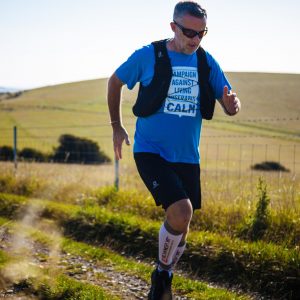‘I attempted suicide twice and was in a hellish situation – breathwork and running has saved me’

Each week, 125 people in the UK sadly take their own lives. A staggering 75% of them are men. Matt Bagwell, 52, is running a 1050km ultra marathon across this month to raise awareness for World Suicide Prevention Day. Here the father-of-two tells the story of how he twice attempted to take his own life and how discovering running and breathwork has saved him – and others – from crisis.
Depression is a demonic illness. The depression I experienced at 23 and again in my early 40s, was so severe, the only way I could see out was to end my life.
Although I was lucky enough to escape suicide thanks to family and friends who intervened, I don’t consider myself cured. I see mental illness as a mental injury and today, I’m in recovery. After years of therapy and stints on medication, I now use running and breathwork as my coping tools.
The problem with mental illness is that, when you’ve hit rock bottom, it’s hard to help yourself. This is why this month, I’m raising awareness of male suicide by running 21 consecutive Ultra Marathons across 43 county borders in England to raise money for the charity CALM (Campaign Against Living Miserably). I want to share my story and how to find hope to people who need it.
Childhood trauma
I struggled to identify what was happening to me the first time I became depressed. I’d suffered – what I know recognise to be – a childhood trauma, after my dad walked out of the family home when I was eight. I had a lack of self love and self value as a result. In hindsight, I realise this was exacerbated when I joined university at 18. I not only had a need to be liked but was also thrown into a competitive world where performance was super important.
My depression was so severe, my GP put me on medication – both beta blockers and antidepressants – and consequently I became incapable of day-to-day functioning. I was in a chronic situation, where I didn’t want to get out of bed. I didn’t want to talk to anybody. I didn’t want to eat. I could see no value in the day and I had no long-term goals. I was desperately anxious for about 18 months. The easiest path to me at the time was to take my own life.
My housemates were the ones who saved me because I was so heavily medicated I couldn’t save myself. They caught me and engaged my family. The conversation around suicide is often centred around statistics and the victims of chronic depression or anxiety, but we should be mindful of the people who are managing the crisis. Many of the calls to CALM are from relatives or friends who are also suffering.
Although I received mental health support through my GP, it didn’t work for me. Back then, I saw therapeutic care as a bit ‘woo-woo’ and needy. Instead, I decided to ‘man up’ and get on with life. I had to resit my final year, then I went straight to London to embark on a marketing career. However, this meant I didn’t take time to deal with any causal issues.
Back to the brink
It wasn’t until 20 years later, when I was going through a divorce which separated me from my two daughters, that I went back to the brink. I realise now, I had cleverly veneered my depression for years – working hard, having a family, owning a nice house and car. But the divorce triggered acute feelings of self loathing. I got to a point where I felt I was a burden on people and creating distress. I numbed the pain with alcohol which sent me into a dark place. It was my now wife Michelle, who I married seven years ago, who saved me.
People react to suicide attempts with questions like ‘Didn’t they think of the consequences? Didn’t they think about their children?’ The reality is, you’re not thinking at all. You’re living in a hellish situation that I wouldn’t wish on anyone.
Recovering from my second suicide attempt was different. I had a stronger friendship network and there was more awareness around depression and mental health issues. I was also economically able to pay for therapy. But it still took years to ‘do the work’ to make me feel like I deserved to live a meaningful and happy life.
I plead with people to care for their mental wellbeing. I have to manage my mental health every day. Running plays a part in that. I find it meditative and therapeutic. I also meet with a personal coach for therapy work and I’ve become a breath work instructor, much of which is therapeutic work. I don’t see it as decadent or self indulgent, it helps me.
My daily morning routine involves a consistent, disciplined practice involving 6am wake ups, 10 minutes of breathing work to energise my body and relieve any anxiety, then some journaling to organise unstructured thoughts. Each day, I set a daily intention; Who do I want to be today? How do I want to turn up? What are the true priorities? I then go for a run and connect with nature. Spending two hours preparing myself in this way makes me feel grateful for the new day.
When I was depressed, one of the first things I’d neglect was eating well. Now I eat a plant-based diet. It helps with the speed of my recovery and any inflammation – the basis of many chronic diseases. I’m not into fads, it’s about the science. By doing all of this, I’m working with my autonomic nervous system, my circadian rhythms and my digestion.
Even if you can just steal 15 minutes from your day to do five minutes of breathing, two minutes of meditation and a walk outside to get some vitamin D, you’d see the benefit to your wellbeing.
How does breathwork help?
Breathwork is a very helpful tool in managing anxiety. It doesn’t take the problems away, but it does help you think more clearly so you can make rational decisions or find solutions. Medication will help smooth the extremes, but it doesn’t solve the cause. You have to ask the questions and practise self care.
Brain fog is a symptom of depression but it was also very common during the pandemic. This happens if you breathe shallow breaths when you’re anxious or stressed. The solution is to oxygenate your brain, in particular your prefrontal cortex (the part of the brain where you think about the future and make positive decisions). You can practise a simple breathwork pattern by breathing in for three seconds through the nose, followed by a quick sigh through the mouth. Repeat this for about a minute.
Another famous technique to slow down the stress is box breathing. Imagine or draw a square and as you trace each side, breathe in through the nose for four seconds, hold for four, breathe out for four, hold for four. It’s been around for many years, but it’s been used by the navy seals and other people in frontline services, including the NHS, because it’s one of the fastest ways to get from sympathetic nervous system to the parasympathetic where we feel calm.
I’ve been inspired by the practises of the Ice Man Wim Hof, as well as Dan Brule and Patrick McKeown, author of The Oxygen Advantage. Now, with the help of social media, breathwork has become more mainstream.
Through the pandemic I took to Instagram to post up to 400 free breathing classes on my platform @lovetolearnto. I knew people were struggling with environmental stress and I wanted to help.
While filming one of these sessions, I actually saved a man from suicide. I happened to take the decision to video on Brighton beach where I live, even though it was a cold, wintery day in February. I noticed a man distressed in the sea so I called the emergency services. I managed to coax him to the water’s edge and drag him out to the shore, despite him being much bigger than me. I gave a thermal hold, where you lie on someone to transfer body heat. I held him and whispered in his ear urging him to breathe. By the time he got to hospital, his body temperature was 26 degrees – death is at 25. It was a miracle I was there at the right time to save him.
My mission is help put breathwork into everyday life. I’m glad sports people such as Lewis Hamilton are practising it and talking about it, because it really helps to have male role models.
The future post-pandemic
I think we’re veering towards a more empathetic culture post-pandemic. Just recently, Nike shut down their headquarters for a week to give everybody a Mental Health Week. That’s just the tip of the iceberg of what I believe organisations need to be doing to help their teams. We’ve seen famous sportswomen Simone Biles and Naomi Osaka step down from games to give their mental health a break. It’s an important lesson to learn.
I have open conversations with my daughters, now 17 and 21. They are well aware of the challenges that I faced in the past, and both of them have regrettably been touched by teenage suicide. But by talking about this openly and raising awareness, I’m positive we can remove the stigma around mental health.
Help Matt raise funds for Calm through his ultra marathon running by donating here
For more on breathwork, click here
If you’re worried about someone, read more about the signs of poor mental health in men










